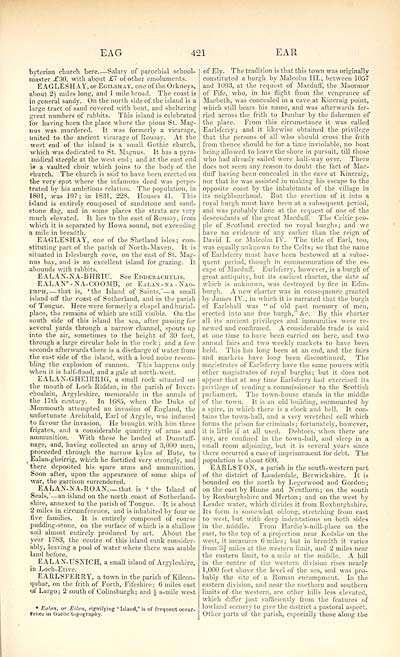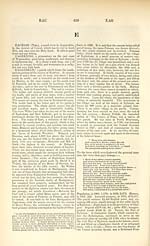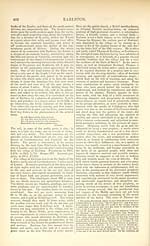Topographical, statistical, and historical gazetteer of Scotland > Volume 1
(507) Page 421
Download files
Complete book:
Individual page:
Thumbnail gallery: Grid view | List view

EAG
421
EAR
byterian clmrch here. — Salary of parochial school-
master £30, with about £7 of other emoluments.
E AGLESHAY, or Egilsbat, one of the Orkneys,
about 2J miles long, and 1 mile broad. The coast is
in general sandy. On the north side of the island is a
large tract of sand covered with bent, and sheltering
great numbers of rabbits. This island is celebrated
for having been the place where the pious St. Mag-
nus was murdered. It was formerly a vicarage,
united to the ancient vicarage of Rousay. At the
west end of the island is a small Gothic church,
which was dedicated to St. Magnus. It has a pyra-
midical steeple at the west end ; and at the east end
is a vaulted choir which joins to the body of the
church. The church is said to have been erected on
the very spot where the infamous deed was perpe-
trated by his ambitious relation. The population, in
1801, was 197; in 1831, 22S. Houses 41. This
island is entirely composed of sandstone and sand-
stone flag, and in some places the strata are very
much elevated. It bes to the east of Rousay, from
which it is separated by Howa sound, not exceeding
a mile in breadth.
EAGLESHAY, one of the Shetland isles; con-
stituting part of the parish of North-Maven. It is
situated in Islesburgh cove, on the east of St. Mag-
nus bay, and is an excellent island for grazing. It
abounds with rabbits.
EALAN-NA-BHRIU. See Edderachylis.
EALAN*-NA-COOMB, or Ealan-na-Nao-
imph, — that is, 'the Island of Saints,' — a small
island off the coast of Sutherland, and in the parish
of Tongue. Here were formerly a chapel and burial-
place, the remains of which are still visible. On the
south side of this island the sea, after passing for
several yards through a narrow channel, spouts up
into the air, sometimes to the height of 30 feet,
through a large circular hole in the rock ; and a few
seconds afterwards there is a discharge of water from
the east side of the island, with a loud noise resem-
bling the explosion of cannon. This happens only
when it is half-flood, and a gale at north-west.
EALAN-GHEIRRIG, a small rock situated on
the mouth of Loch Riddan, in the parish of Inver-
choalain, Argyleshire, memorable in the annals of
the 17th century. In 1685, when the Duke of
Monmouth attempted an invasion of England, the
unfortunate Archibald, Earl of Argyle, was induced
to favour the invasion. He brought with him three
frigates, and a considerable quantity of arms and
ammunition. With these he landed at Dunstaff-
nage, and, having collected an army of 3,000 men,
proceeded through the narrow kyles of Bute, to
Ealan-gheirrig, which he fortified very strongly, and
' there deposited his spare arms and ammunition.
Soon after, upon the appearance of some ships of
war, the garrison surrendered.
EALAN-NA-ROAN, — that is 'the Island of
Seals,' — an island on the north coast of Sutherland-
shire, annexed to the parish of Tongue. It is about
2 miles in circumference, and is inhabited by four or
five families. It is entirely composed of coarse
pudding-stone, on the surface of which is a shallow
soil almost entirely produced by art. About the
year 1783, the centre of this island sunk consider-
ably, leaving a pool of water where there was arable
land before.
EALAN-USNICH, a small island of Argyleshire,
in Loch-Etive.
EARLSFERRY, a town in the parish of Kilcon-
quhar, on the frith of Forth, Fifeshire; 6 miles east
of Largo; 2 south of Colinsburgh ; and h a-mile west
* Eaton, or Eihm, signifying ' Island,' is of frequent occur-
rence in Gaelic topography.
of Ely. The tradition is that this town was originally
constituted a burgh by Malcolm III., between 1057
and 1093, at the request of Macduff, the Maormor
of Fife, who, in his flight from the vengeance of
Macbeth, was concealed in a cave at Kincraig point,
which still bears his name, and was afterwards fer-
ried across the frith to Dunbar by the fishermen of
the place. From this circumstance it was called
Earlsferry; and it likewise obtained the privilege
that the persons of all who should cross the frith
from thence should be for a time inviolable, no boat
being allowed to leave the shore in pursuit, till those
who had already sailed were half-way over. There
does not seem any reason to doubt the fact of Mac-
duff having been concealed in the cave at Kincraig,
nor that he was assisted in making his escape to the
opposite coast by the inhabitants of the village in
its neighbourhood. But the erection of it into a
royal burgh must have been at a subsequent period,
and was probably done at the request of one of the
descendants of the great Macduff. The Celtic peo-
ple of Scotland erected no royal burghs; and we
have no evidence of any earlier than the reign of
David I. or Malcolm IV. The title of Earl, too,
was equally unknown to the Celts; so that the name
of Earlsferry must have been bestowed at a subse-
quent period, though in commemoration of the es-
cape of Macduff. Earlsferry, however, is a burgh of
great antiquity, but its earliest charter, the date of
which is unknown, was destroyed by fire in Edin-
burgh. A new charter was in consequence granted
by James IV., in which it is narrated that the burgh
of Earlshall was " of old past memory of men,
erected into ane free burgh," &c. By this charter
all its ancient privileges and immunities were re-
newed and confirmed. A considerable trade is said
at one time to have been carried on here, and two
annual fairs and two weekly markets to have been
held. This has long been at an end, and the fairs
and markets have long been discontinued. The
magistrates of Earlsferry have the same powers with
other magistrates of roj'al burghs; but it does not
appear that at any time Earlsferry had exercised its
privilege of sending a commissioner to the Scottish
parliament. The town-house stands in the middle
of the town. It is an old building, surmounted by
a spire, in which there is a clock and bell. It con-
tains the town-hall, and a very wretched cell which
forms the prison for criminals ; fortunately, however,
it is little if at all used. Debtors, when there are
any, are confined in the town-hall, and sleep in a
small room adjoining, but it is several years since
there occurred a case of imprisonment for debt. The
population is about 600.
EARLSTON, a parish in the south-western part
of the district of Lauderdale, Berwickshire. It is
bounded on the north by Legerwood and Gordon;
on the east by Hume and Nenthorn; on the south
by Roxburghshire and Merton ; and on the west by
Leader water, which divides it from Roxburghshire.
Its form is somewhat oblong, stretching from east
to west, but with deep indentations on both sides
in the middle. From Hardie's-mill-place on the
east, to the top of a projection near Kedslie on the
west, it measures 6 miles; but in breadth it varies
from 3J miles at the western limit, and 2 miles near
the eastern limit, to a mile at the middle. A hill
in the centre of the western division rises nearly
1,000 feet above the level of the sea, and was pro-
bably the site of a Roman encampment. In the
eastern division, and near the northern and southern
limits of the western, are other hills less elevated,
which differ just sufficiently from the features of
lowland scenery to give the district a pastoral aspect.
Other parts of the parish, especially those along the
421
EAR
byterian clmrch here. — Salary of parochial school-
master £30, with about £7 of other emoluments.
E AGLESHAY, or Egilsbat, one of the Orkneys,
about 2J miles long, and 1 mile broad. The coast is
in general sandy. On the north side of the island is a
large tract of sand covered with bent, and sheltering
great numbers of rabbits. This island is celebrated
for having been the place where the pious St. Mag-
nus was murdered. It was formerly a vicarage,
united to the ancient vicarage of Rousay. At the
west end of the island is a small Gothic church,
which was dedicated to St. Magnus. It has a pyra-
midical steeple at the west end ; and at the east end
is a vaulted choir which joins to the body of the
church. The church is said to have been erected on
the very spot where the infamous deed was perpe-
trated by his ambitious relation. The population, in
1801, was 197; in 1831, 22S. Houses 41. This
island is entirely composed of sandstone and sand-
stone flag, and in some places the strata are very
much elevated. It bes to the east of Rousay, from
which it is separated by Howa sound, not exceeding
a mile in breadth.
EAGLESHAY, one of the Shetland isles; con-
stituting part of the parish of North-Maven. It is
situated in Islesburgh cove, on the east of St. Mag-
nus bay, and is an excellent island for grazing. It
abounds with rabbits.
EALAN-NA-BHRIU. See Edderachylis.
EALAN*-NA-COOMB, or Ealan-na-Nao-
imph, — that is, 'the Island of Saints,' — a small
island off the coast of Sutherland, and in the parish
of Tongue. Here were formerly a chapel and burial-
place, the remains of which are still visible. On the
south side of this island the sea, after passing for
several yards through a narrow channel, spouts up
into the air, sometimes to the height of 30 feet,
through a large circular hole in the rock ; and a few
seconds afterwards there is a discharge of water from
the east side of the island, with a loud noise resem-
bling the explosion of cannon. This happens only
when it is half-flood, and a gale at north-west.
EALAN-GHEIRRIG, a small rock situated on
the mouth of Loch Riddan, in the parish of Inver-
choalain, Argyleshire, memorable in the annals of
the 17th century. In 1685, when the Duke of
Monmouth attempted an invasion of England, the
unfortunate Archibald, Earl of Argyle, was induced
to favour the invasion. He brought with him three
frigates, and a considerable quantity of arms and
ammunition. With these he landed at Dunstaff-
nage, and, having collected an army of 3,000 men,
proceeded through the narrow kyles of Bute, to
Ealan-gheirrig, which he fortified very strongly, and
' there deposited his spare arms and ammunition.
Soon after, upon the appearance of some ships of
war, the garrison surrendered.
EALAN-NA-ROAN, — that is 'the Island of
Seals,' — an island on the north coast of Sutherland-
shire, annexed to the parish of Tongue. It is about
2 miles in circumference, and is inhabited by four or
five families. It is entirely composed of coarse
pudding-stone, on the surface of which is a shallow
soil almost entirely produced by art. About the
year 1783, the centre of this island sunk consider-
ably, leaving a pool of water where there was arable
land before.
EALAN-USNICH, a small island of Argyleshire,
in Loch-Etive.
EARLSFERRY, a town in the parish of Kilcon-
quhar, on the frith of Forth, Fifeshire; 6 miles east
of Largo; 2 south of Colinsburgh ; and h a-mile west
* Eaton, or Eihm, signifying ' Island,' is of frequent occur-
rence in Gaelic topography.
of Ely. The tradition is that this town was originally
constituted a burgh by Malcolm III., between 1057
and 1093, at the request of Macduff, the Maormor
of Fife, who, in his flight from the vengeance of
Macbeth, was concealed in a cave at Kincraig point,
which still bears his name, and was afterwards fer-
ried across the frith to Dunbar by the fishermen of
the place. From this circumstance it was called
Earlsferry; and it likewise obtained the privilege
that the persons of all who should cross the frith
from thence should be for a time inviolable, no boat
being allowed to leave the shore in pursuit, till those
who had already sailed were half-way over. There
does not seem any reason to doubt the fact of Mac-
duff having been concealed in the cave at Kincraig,
nor that he was assisted in making his escape to the
opposite coast by the inhabitants of the village in
its neighbourhood. But the erection of it into a
royal burgh must have been at a subsequent period,
and was probably done at the request of one of the
descendants of the great Macduff. The Celtic peo-
ple of Scotland erected no royal burghs; and we
have no evidence of any earlier than the reign of
David I. or Malcolm IV. The title of Earl, too,
was equally unknown to the Celts; so that the name
of Earlsferry must have been bestowed at a subse-
quent period, though in commemoration of the es-
cape of Macduff. Earlsferry, however, is a burgh of
great antiquity, but its earliest charter, the date of
which is unknown, was destroyed by fire in Edin-
burgh. A new charter was in consequence granted
by James IV., in which it is narrated that the burgh
of Earlshall was " of old past memory of men,
erected into ane free burgh," &c. By this charter
all its ancient privileges and immunities were re-
newed and confirmed. A considerable trade is said
at one time to have been carried on here, and two
annual fairs and two weekly markets to have been
held. This has long been at an end, and the fairs
and markets have long been discontinued. The
magistrates of Earlsferry have the same powers with
other magistrates of roj'al burghs; but it does not
appear that at any time Earlsferry had exercised its
privilege of sending a commissioner to the Scottish
parliament. The town-house stands in the middle
of the town. It is an old building, surmounted by
a spire, in which there is a clock and bell. It con-
tains the town-hall, and a very wretched cell which
forms the prison for criminals ; fortunately, however,
it is little if at all used. Debtors, when there are
any, are confined in the town-hall, and sleep in a
small room adjoining, but it is several years since
there occurred a case of imprisonment for debt. The
population is about 600.
EARLSTON, a parish in the south-western part
of the district of Lauderdale, Berwickshire. It is
bounded on the north by Legerwood and Gordon;
on the east by Hume and Nenthorn; on the south
by Roxburghshire and Merton ; and on the west by
Leader water, which divides it from Roxburghshire.
Its form is somewhat oblong, stretching from east
to west, but with deep indentations on both sides
in the middle. From Hardie's-mill-place on the
east, to the top of a projection near Kedslie on the
west, it measures 6 miles; but in breadth it varies
from 3J miles at the western limit, and 2 miles near
the eastern limit, to a mile at the middle. A hill
in the centre of the western division rises nearly
1,000 feet above the level of the sea, and was pro-
bably the site of a Roman encampment. In the
eastern division, and near the northern and southern
limits of the western, are other hills less elevated,
which differ just sufficiently from the features of
lowland scenery to give the district a pastoral aspect.
Other parts of the parish, especially those along the
Set display mode to: Large image | Transcription
Images and transcriptions on this page, including medium image downloads, may be used under the Creative Commons Attribution 4.0 International Licence unless otherwise stated. ![]()
| Gazetteers of Scotland, 1803-1901 > Topographical, statistical, and historical gazetteer of Scotland > Volume 1 > (507) Page 421 |
|---|
| Permanent URL | https://digital.nls.uk/97443630 |
|---|
| Description | Volume first. A-H. |
|---|---|
| Attribution and copyright: |
|

